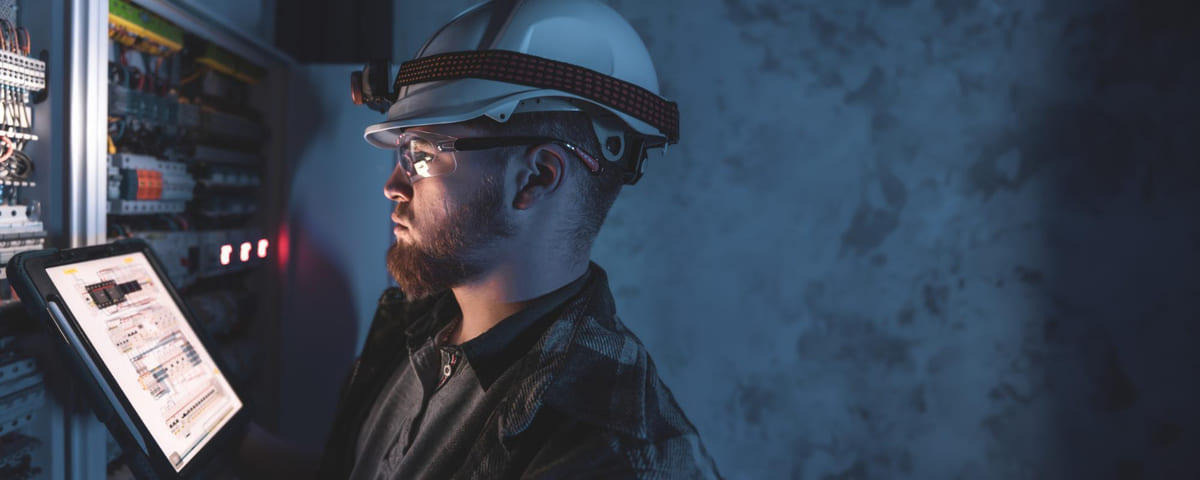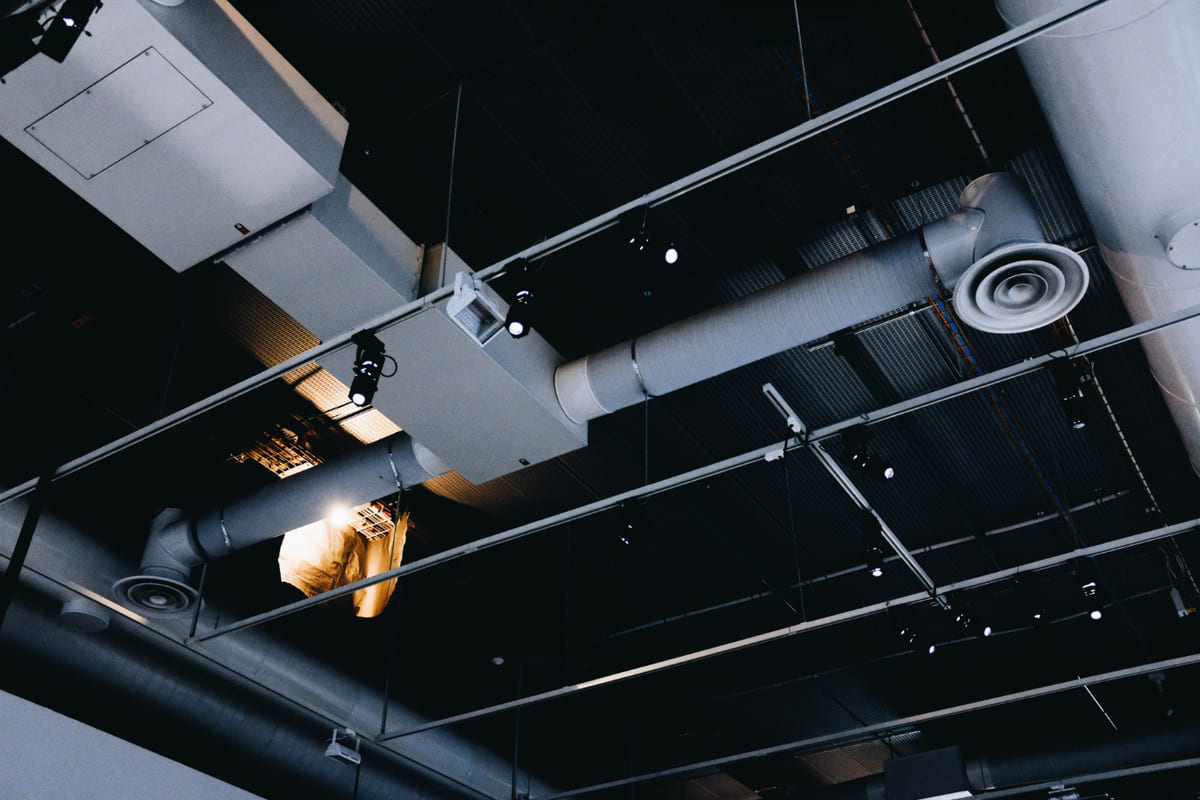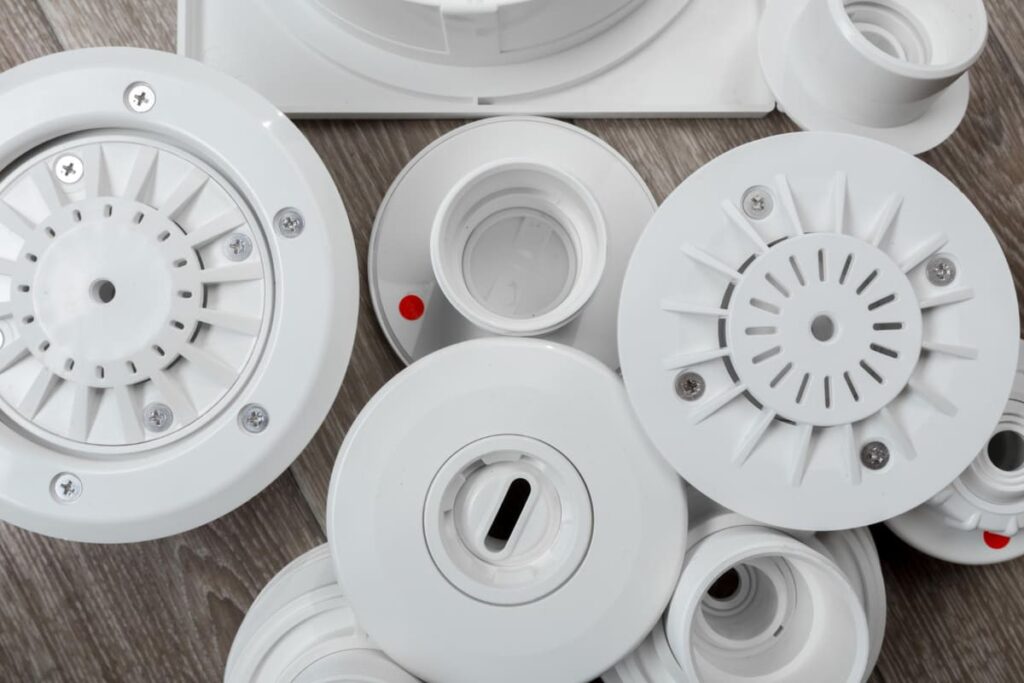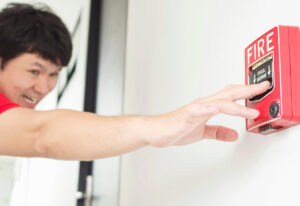Fire safety is a critical concern on construction sites. Across the globe, large projects face fire risks daily – from welding sparks to faulty wiring. Such hazards can ignite fires that threaten lives, damage structures, and derail project timelines. Fortunately, modern Types of Fire Detection Sensors are smarter and more adaptable than ever. This article examines common fire problems on construction sites and how the top five fire detection sensor types of 2025 – Smoke, Heat, Flame, Multi-Sensor, and Air Sampling systems – provide effective solutions. Written in a clear, didactic style for construction staff, safety managers, and fire system designers, it offers an objective look at improving site safety with cutting-edge sensor technology.
Table of Contents
Problems and Consequences
Fire hazards are an ever-present threat in construction. Projects often involve open flames, temporary electrical setups, and abundant combustible materials. Understanding these problems and their consequences is the first step toward prevention.
Common Fire Hazards on Construction Sites
-
Hot Works (Welding and Cutting): Activities like welding, grinding, and soldering produce sparks and high heat. If proper precautions are not taken, these sparks can ignite scaffolding, insulation, or other nearby combustibles. Even a momentary lapse in supervision during hot works can start a fire that spreads rapidly through unfinished structures.
-
Electrical Faults: Temporary power supplies and incomplete electrical installations pose a major risk. Damaged cables, overloaded circuits, and faulty tools can short-circuit or overheat. An exposed wire or a malfunctioning generator on-site may create an ignition source in the presence of wood framing or construction dust.
-
Flammable Materials Storage: Construction sites often store fuel, gas cylinders, paints, solvents, and other flammable chemicals. Without careful handling and segregated storage, these materials can feed intense fires. For example, a small spark near a fuel depot or solvent drum can trigger an explosion or a fast-spreading blaze.
-
Poor Housekeeping and Waste: Accumulated debris, packaging, and scrap materials become ready fuel for fire. If trash and lumber off-cuts are left strewn about, a tiny ignition source can turn a cluttered area into an inferno. Poor housekeeping also means more obstacles, allowing fires to spread unchecked and hindering firefighters’ access.
-
Lack of Fire Protection During Construction: In early construction phases, permanent fire protection (like sprinkler systems) is usually not operational. Alarm systems might also not be fully installed or active. This gap means a fire can grow larger before anyone notices. Additionally, some workers may be tempted to disable smoke alarms to avoid nuisance alarms from dust, leaving the site unmonitored. Deliberate acts like arson or careless smoking on-site further compound the risk when detection systems are absent.
Potential Consequences of Construction Site Fires
-
Project Delays and Cost Overruns: A fire can bring construction to a sudden halt. Damage must be assessed and rebuilt, requiring additional materials and labor. Weeks or months of progress might be lost. These delays often cause cascade effects – missing contract deadlines, incurring financial penalties, and pushing back the opening of the facility. In many cases, contractors face significant cost overruns from rebuilding work and renting replacement equipment.
-
Structural Damage and Integrity Loss: Partially built structures are especially vulnerable to fire. Critical components like wooden formwork, structural steel, or concrete frameworks can be weakened or destroyed by intense heat. A severe blaze might lead to collapse of scaffolding or deformation of steel beams. Even if the structure remains standing, the materials’ integrity could be compromised, requiring demolition of damaged sections and re-engineering of the design.
-
Loss of Equipment and Materials: Construction sites host valuable machinery (cranes, generators, tools) and building materials (lumber, insulation, wiring). A fire can ruin large quantities of these before it’s contained. The financial hit from replacing burnt materials and equipment is high. Additionally, long lead times to get new materials (for instance, custom-fabricated components) can further stall the project.
-
Worker Injuries and Safety Risks: The safety of construction workers is paramount, and fires put lives in immediate danger. Workers caught in a fast-moving fire can suffer burns or smoke inhalation, and in worst cases, fatalities occur. Even those not injured may face psychological trauma. A fire during work hours requires a rapid evacuation of what is often a complex, unfinished structure – a challenging scenario that can lead to chaos if not planned for. Every incident undermines morale and trust in site safety practices.
-
Legal Liability and Reputational Damage: Beyond physical and financial damage, a fire can result in legal and reputational consequences. Investigations may find negligence in safety measures, leading to fines or lawsuits against contractors. The project owners and construction firms also risk damage to their reputation. High-profile construction fires make news headlines, potentially impacting public trust and future business. In the aftermath, regulatory authorities often heighten scrutiny on similar projects, adding further complications and costs.
Real-world examples underline these consequences. In 2019, a fire during renovation of Paris’s Notre Dame Cathedral caused catastrophic structural damage and a multi-year delay in the project. In another case, a nearly completed apartment complex in the USA was destroyed by an overnight blaze, resulting in a total loss of the building and tens of millions in damage. Tragically, there have also been fatal incidents, such as a 2023 fire on a high-rise construction site in Charlotte, NC, where two workers lost their lives. These incidents highlight how fires can derail construction progress and why rigorous fire risk management is essential at every stage.
Suggested article to read: 30 Crucial Safety Solutions for Managing Hazardous Building Sites in 2024

Solutions with Sensors
Modern fire detection technology offers powerful solutions to mitigate these risks. By deploying smart fire detection sensors, construction teams can catch incipient fires before they rage out of control. As of 2025, the top five types of fire detection sensors leading the charge are Smoke Detectors, Heat Detectors, Flame Detectors, Multi-Sensor Detectors, and Air Sampling Smoke Detection (ASD) systems. Each plays a unique role in enhancing safety. They can be used in permanent installations (as part of a completed building’s fire system) and as temporary safeguards during construction. Below, we explore each sensor type, how it works, and use cases demonstrating its value in large-scale construction or renovation projects.
1. Smoke Detectors
Smoke detectors are the most widely used fire sensors, designed to detect the earliest visible or invisible byproducts of combustion. They typically operate on one of two principles: photoelectric sensors that sense particles of smoke through light scattering, or ionization sensors that detect combustion gases. In both cases, when smoke from a fire enters the detector, it triggers an alarm. Modern smoke detectors often combine both principles or use advanced optics to improve reliability. By 2025, many smoke detectors are “smart” – featuring built-in microprocessors to analyze signals and connectivity to communicate with central systems or even smartphones.
Permanent Installations: In finished buildings, smoke detectors form the backbone of the fire alarm system. They are strategically placed on ceilings or high on walls in nearly every room and corridor. In a smart building, addressable smoke detectors report their location and status to a fire alarm control panel, so responders know exactly where the smoke is.
For example, a modern high-rise office tower might have thousands of smoke detectors networked together. If a single detector senses smoke in an electrical room, it sends a signal pinpointing the room location. This early warning allows building management to investigate or evacuate before flames spread. Smoke detectors have repeatedly proven their worth – a detector in a shopping mall electrical closet can alert security to a smoldering wire before a major fire breaks out, preventing extensive damage.
Temporary Construction Use: On construction sites, installing traditional wired smoke detectors can be challenging, so wireless smoke detection systems are often used. Temporary battery-powered smoke detectors can be mounted on poles or walls around the site and linked via radio to a central alarm unit. These units continuously monitor the area for any whiff of smoke. For instance, during the construction of a large mixed-use development in the UK, the contractors deployed a wireless smoke alarm network across the site. When an overheating piece of equipment in a basement level began to smolder, a smoke detector on the temporary system sensed the developing smoke.
It immediately sent an alert through the wireless network, sounding alarms throughout the site. Workers were able to respond with extinguishers and stop the fire in its infancy. This case illustrates how even in the rough, changing environment of a building under construction, smoke detectors can provide crucial early warnings. Many such systems are reusable and can move as the project evolves – protecting new areas as structures rise. By catching fires at the first sign of smoke, these detectors help avoid the massive losses that can result if a fire grows unnoticed.
2. Heat Detectors
Heat detectors respond to the temperature changes caused by fire. Unlike smoke detectors, they do not react to particles, only to heat energy. There are two main types: fixed-temperature detectors which trigger an alarm once the ambient temperature exceeds a set threshold, and rate-of-rise detectors which alarm if the temperature climbs rapidly by a certain number of degrees. Some units combine both functions.
In 2025, heat detectors are more sophisticated, with electronic sensors that can continuously measure temperature and even distinguish normal fluctuations from a genuine fire condition. Heat detectors are inherently slower to react than smoke detectors for smoldering fires (since it takes time for heat to build up), but they are extremely reliable and less prone to false alarms in dirty or dusty conditions.
Permanent Installations: Heat detectors are typically installed in environments where smoke detectors might false alarm or where fires may not produce much smoke. Common locations are kitchens, boiler rooms, garages, or mechanical spaces. For example, in a commercial kitchen of a new hotel, heat detectors are used because occasional smoke from cooking could constantly trigger a smoke detector. If a fire erupts on a stovetop and raises the temperature rapidly, a rate-of-rise heat sensor in the hood will trip and activate the kitchen’s fire suppression system.
Another scenario is an unheated warehouse: a special heat detector rated for low temperatures will detect a fire even in freezing conditions where smoke detectors might malfunction. The key benefit is that heat detectors provide a dependable alarm when a fire grows hot, with minimal nuisance alarms from dust, steam, or cooking aerosols. Modern addressable heat detectors can report the temperature reading to the control panel, giving insight into developing conditions (e.g., a gradually heating machine before it flames out).
Temporary Construction Use: On construction sites, heat detectors are valuable in areas with high dust or airborne particles (which often set off smoke alarms falsely). For instance, during a major tunnel excavation project, contractors placed portable heat detectors in the work zones because heavy dust from drilling made smoke detection impractical. If a piece of equipment in the tunnel started to overheat and catch fire, the rising temperature would trigger the detector’s alarm.
In another example, consider welding operations inside a partially constructed chemical plant. Welding is a hot work that can inadvertently ignite surrounding material. By mounting heat detectors on temporary stands around the welding area, the site safety team can get an instant alarm if the ambient heat suddenly spikes from an uncontrolled fire. These detectors can tie into a temporary alarm panel or a wireless notification system to alert supervisors. While heat sensors might not catch a small, smoky fire as quickly as a smoke detector, they add a layer of protection that is immune to the usual site pollutants.
3. Flame Detectors
Flame detectors are specialized sensors that “see” the actual flames of a fire. They use optical sensors tuned to the specific wavelengths of light emitted by flames – typically ultraviolet (UV) or infrared (IR) light. Some advanced models, called triple IR or UV/IR flame detectors, use multiple spectral sensors to improve reliability and avoid false triggers (for example, distinguishing genuine flames from sunlight reflections or hot work sparks).
When a flame detector’s field of view includes a flame, even a small one, it can detect the fire in a fraction of a second by the unique flickering frequencies and wavelengths produced. This makes flame detectors the fastest type of sensor for certain fires. By 2025, flame detectors often incorporate smart processing to ignore false sources and some even include built-in cameras to verify a fire visually.

Permanent Installations: Flame detectors are commonly used in high-hazard industrial settings or large open areas where a fire would likely be flame-rich (as opposed to a slow smoldering). For example, in an aircraft hangar or a petrochemical plant, a flame detector can be mounted on the ceiling or walls overlooking critical equipment. If a flammable gas leak ignites into a flash fire, the UV/IR flame detector will sense the ultraviolet and infrared radiation from the flames almost instantly, faster than smoke could reach a smoke detector or heat could build up at a heat detector.
The system can then activate alarms and even trigger fire suppression systems (like foam sprayers) within seconds. In smart buildings, flame detectors might be used in atriums or large public spaces in combination with CCTV – if someone were to set a fire (arson attempt), the flame detector would catch the flame and security cameras could zoom in to assess.
Temporary Construction Use: On construction sites, flame detectors are less common than smoke or heat sensors, but they are invaluable for certain high-risk activities. One use case is during hot works in sensitive or enclosed areas. Imagine a historic theater undergoing renovation, where workers are using open-flame torches to remove old paint. Because the venue is precious and filled with woodwork, the project team installed a temporary flame detector overlooking the stage area being worked on. If a stray flame from a torch caught the old curtain or timber framing, the detector would immediately sense the new flame and set off an alarm, prompting an evacuation and response before the fire could spread.
4. Multi-Sensor Detectors
Multi-sensor detectors (also known as multi-criteria detectors) are an advanced type of fire sensor that combine multiple detection technologies into one unit. Instead of relying on a single indicator (just smoke, just heat, or just flame), these detectors monitor several factors – typically smoke, heat, and sometimes gas (carbon monoxide) or light signals – and use algorithms to interpret them together. The goal is to detect a real fire as quickly as possible while filtering out false alarms.
For example, a multi-sensor device might notice a small amount of smoke but also check for a corresponding heat rise; if both are present, it confirms a fire, but if only smoke is detected (perhaps from dust or steam), it stays on alert without triggering a full alarm. By 2025, multi-sensor detectors have become popular in smart buildings because of their reliability. They often come with built-in microprocessors (essentially tiny computers) that run intelligent software to decide when to alarm. This integrated approach greatly reduces nuisance alarms and can catch certain types of fires faster by looking at multiple clues.
Permanent Installations: Many new large buildings and complexes now specify multi-sensor detectors as the standard device in their fire protection systems. Take the example of a modern airport terminal. Such a space can experience very different conditions – from vehicle exhaust fumes to cooking smoke in restaurants – that might confuse a traditional single-sensor detector. Multi-sensor detectors installed throughout the terminal constantly evaluate each area for signs of fire.
If a small fire starts in a maintenance closet, the detector senses smoke particles and an increasing temperature, and within seconds it triggers an alarm, confirming a genuine fire. However, if there’s only a burst of dust from construction work or steam from a HVAC vent, the detector registers particles but no heat, and it intelligently holds off to avoid a false alarm. This capability is vital in places like hotels, high-rise offices, and shopping malls where false evacuations are disruptive and costly.
Temporary Construction Use: During construction or renovation projects, multi-sensor detectors can be a smart choice for temporary fire protection, especially in complex environments. For instance, consider the renovation of a large historical museum. Such a project must balance fire safety with ongoing work that produces dust and occasional smoke from tools. By deploying temporary multi-sensor detectors in the galleries under renovation, the project team can maintain fire detection without constant false alarms.
These detectors might be programmed to be a bit less sensitive to mere particulates, since construction dust is prevalent, but if an actual fire starts (producing smoke plus heat), they will alarm. In one real example, a contractor retrofitting an airport terminal extension used wireless multi-sensor devices during construction. Each unit monitored both smoke and heat in the unfinished areas. One evening, an air-conditioning unit under testing began to smolder and overheat, producing a mix of smoke and heat. A multi-sensor on the ceiling detected the combined signals and sent an alert to the site supervisor’s phone via the wireless system.
5. Air Sampling Smoke Detection (ASD) Systems
Air Sampling Smoke Detection systems, often referred to by the leading brand acronym ASD or names like aspirating smoke detectors, represent the pinnacle of early-warning fire detection technology. Instead of passively waiting for smoke to waft up to a detector on the ceiling, an ASD system actively draws air through a network of small pipes or tubing to a central detection unit. Inside the detector, the air is continuously analyzed for microscopic smoke particles (and some systems also check for gases). ASDs are incredibly sensitive – they can detect the very first traces of combustion, even before visible smoke is evident.
These systems can often be configured with multiple alarm thresholds (for example, an alert at the earliest hint of smoke, and an alarm at a slightly higher concentration) to allow for staged responses. In 2025, ASD technology has advanced with better filtration (to avoid dust issues) and higher discrimination using laser-based sensing and even AI algorithms. They are generally more costly than standard detectors, so they are used where high-value assets or early detection is paramount.
Permanent Installations: Aspirating smoke detectors are commonly found in facilities where an undetected fire would be catastrophic or where traditional detectors struggle. Typical installations include data centers, telecommunication hubs, archives, large indoor stadiums, and airports. For example, a state-of-the-art data center housing servers for banks might use an ASD system. Fine tubing runs above and below the server racks, constantly sampling air. If a single wire starts overheating and the insulation begins to char, the ASD unit senses a slight uptick in smoke particulate at, say, 0.001% obscuration per meter (extremely low level).

It can issue a warning to staff before any flame breaks out or standard smoke alarms would ever activate. This early warning might give staff time to investigate and power down equipment, preventing a full fire. In large open spaces with high ceilings, like an airport check-in hall, ASD systems outperform regular smoke detectors because smoke from a small fire would dilute and rise slowly. By actively drawing smoke to a detector, ASDs can detect a fire in, for instance, a trash bin in the airport hall long before ceiling detectors would sense it. Another case study comes from a historic government library, where ASD pipes were discreetly installed along the ceiling beams.
Temporary Construction Use: Air sampling systems can also be adapted for construction site use, especially during critical phases or in protecting valuable parts of a project. One approach is portable ASD units. For example, during the restoration of a famous opera house, the project team installed a temporary ASD system in the attic space as soon as a new roof was in place.
The reason was that this attic contained historic wooden structures and new electrical work, a combination at risk of slow, smoldering fires (like an electrical cable slowly heating in old timber). The ASD pipes were run through the attic and the detection unit was placed in the site office. One night, the ASD alarm signaled elevated smoke particles in the attic. Workers investigated and discovered an electrical junction box smoking due to a wiring fault, and they fixed it before it could ignite the wood.
FAQs
How do multi-sensor fire detectors reduce false alarms?
Multi-sensor fire detectors combine inputs from different sensors (smoke, heat, and sometimes carbon monoxide) and use a smart algorithm to decide if there’s a real fire. This means the detector might see some smoke, but it will check if heat is also rising before it triggers an alarm. By cross-verifying multiple signals, multi-sensor units are much less likely to alarm from non-fire sources like dust, steam, or cooking fumes. In essence, all the sensor data is analyzed together.
If only one sensor is triggered (say, some dust mimics smoke), the device can recognize that it’s probably a false alarm and wait. If several criteria are met (smoke particles plus a temperature increase, for example), it quickly sounds the alarm. This smart approach dramatically cuts down on false alarms while still responding fast to genuine fires.
What is an air sampling smoke detection system?
An air sampling smoke detection system (ASD) is a very sensitive fire detection setup that actively samples air from the environment. Instead of using spot detectors on the ceiling, an ASD uses a network of small pipes with holes, spread throughout the protected area (like across a room or inside equipment cabinets).
A suction fan draws air continuously through these pipes back to a central, highly sensitive smoke sensor (often laser-based) that can detect extremely tiny amounts of smoke. If smoke particles are present – even at levels far below what a normal detector would need – the system raises an alert or alarm. Because it is actively pulling air in, an ASD can detect a fire at a very early stage, even before visible smoke accumulates.
Which fire detection sensors are ideal for construction site use?
Construction sites benefit most from robust, portable, and reliable fire detection sensors. Typically, a combination of smoke and heat detectors is used on sites. Many contractors deploy wireless smoke/heat detectors that can be easily installed around the site and relocated as needed. These wireless units form a temporary alarm system to cover site offices, high-risk work areas, and temporary enclosures. Heat detectors are ideal for very dusty or smoky work zones (where a smoke detector might false alarm), while smoke detectors can cover enclosed spaces like storage rooms or site sheds for early warning.
For specific high-risk activities such as welding or cutting (hot works), flame detectors might be set up to instantly catch any sudden blaze. In special cases, like when renovating a historic building or when a part of the new building is already housing sensitive equipment, portable air sampling detectors can be installed to give extra early detection. In summary, the best approach on a construction site is a mix of these sensors: wireless smoke and heat detectors for general coverage, flame detectors watching any fuel or hot work areas, and even aspirating systems for critical zones. All these should tie into a central alert system so that if any detector senses trouble, workers are alerted immediately to take action.
Is it true that heat detectors respond slower than smoke detectors?
Yes, generally heat detectors are slower to respond to a fire than smoke detectors. The reason is that heat detectors wait until there is a significant temperature rise or high heat at the detector. In a developing fire, smoke is often produced in volume before the heat builds up enough to trigger a heat detector (especially for smoldering fires or fires in a different part of the room). Smoke detectors, by contrast, can pick up on the smoke particles from a fire’s early stages, sometimes when the fire is still relatively small or cool.
For example, if an electrical appliance starts smoldering and producing smoke, a smoke alarm will likely trigger while the room is still only warm, long before a heat detector (which might require the room to reach around 135°F/57°C or a rapid temperature jump) goes off. Because of this, building codes often use smoke detectors as the primary life safety alarms in most spaces. Heat detectors are used in supplementary roles or in places where smoke detectors can’t be used.
Conclusion
Fire safety during construction is as crucial as in the finished building – perhaps even more so, given the array of ignition sources and the absence of permanent safeguards. In 2025, construction teams have an impressive arsenal of Types of Fire Detection Sensors at their disposal to enhance safety. By understanding the strengths of smoke, heat, flame, multi-sensor, and air sampling detectors, safety managers can design layered protection that addresses the specific risks of each site. Smoke detectors provide broad early warning, heat detectors offer reliability in harsh conditions, flame detectors give instantaneous alerts for open fires, multi-sensor units intelligently discriminate real fires from false alarms, and ASD systems deliver the earliest possible detection for critical areas.
Combining these technologies in a smart, site-specific way – and using modern features like wireless networks and remote monitoring – turns a construction site into a safer environment. In practice, this means welding areas are watched by flame sensors, dusty zones by heat detectors, general areas by smoke or multi-sensor units, and high-value spots by aspirating systems. Real-world projects from skyscrapers to historic restorations have shown that investing in proper fire detection not only averts costly incidents but also protects lives. As construction projects continue to grow in scale and complexity, embracing these top five sensor types ensures that fire safety keeps pace.
Resources:
-
National Fire Protection Association (NFPA). (2023). Fires in Structures Under Construction. NFPA Research Report (by R. Campbell, Oct 2023).
-
Health and Safety Executive (HSE). (2022). Fire safety in construction (HSG168, Third edition). HSE Guidance for construction projects.
-
Euralarm. (2025). White Paper: How Multi-Sensor Fire Detectors Can Reduce False Alarms. Euralarm Industry Report, Jan 2025.
-
Ramtech Electronics. (2024). The Copenhagen Stock Exchange Fire and Lessons from Notre Dame. Case Study Blog, Apr 2024.
For all the pictures: Freepik
Suggested article for reading:
Top 7 Predictive Maintenance IoT Use Cases in Construction Industry
4 Main Types of Vibration Sensors Used in Modern Construction Projects
5 Key Benefits of Using Water Leakage Sensors in Construction
Motion Detector for Construction Sites; 2025 Guide
9 Tips to Win Tenders in Construction





